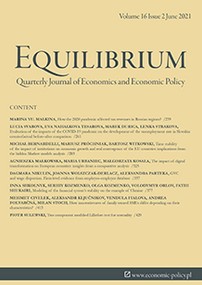Time stability of the impact of institutions on economic growth and real convergence of the EU countries: implications from the hidden Markov models analysis
Time stability of the impact of institutions on economic growth and real convergence of the EU countries: implications from the hidden Markov models analysis
Author(s): Michał Bernardelli, Mariusz Próchniak, Bartosz WitkowskiSubject(s): National Economy, Economic history, Methodology and research technology, Economic development, Transformation Period (1990 - 2010), Present Times (2010 - today), EU-Accession / EU-DEvelopment
Published by: Instytut Badań Gospodarczych
Keywords: catching up; convergence; Bayesian model averaging; hidden Markov models; Viterbi path;
Summary/Abstract: Research background: It is not straightforward to identify the role of institutions for the economic growth. The possible unknown or uncertain areas refer to nonlinearities, time stability, transmission channels, and institutional complementarities. The research problem tackled in this paper is the analysis of the time stability of the relationship between institutions and economic growth and real economic convergence. Purpose of the article: The article aims to verify whether the impact of the institutional environment on GDP dynamics was stable over time or diffed in various subperiods. The analysis covers the EU28 countries and the 1995–2019 period. Methods: We use regression equations with time dummies and interactions to assess the stability of the impact of institutions on economic growth. The analysis is based on the partially overlapping observations. The models are estimated with the use of Blundell and Bond’s GMM system estimator. The results are then averaged with the Bayesian Model Averaging (BMA) approach. Structural breaks are identified on the basis of the Hidden Markov Models (HMM). Findings & value added: The value added of the study is threefold. First, we use the HMM approach to find structural breaks. Second, the BMA method is applied to assess the robustness of the outcomes. Third, we show the potential of HMM in foresighting. The results of regression estimates indicate that good institution reflected in the greater scope of economic freedom and better governance lead to the higher economic growth of the EU countries. However, the impact of institutions on economic growth was not stable over time.
Journal: Equilibrium. Quarterly Journal of Economics and Economic Policy
- Issue Year: 16/2021
- Issue No: 2
- Page Range: 285-323
- Page Count: 39
- Language: English

